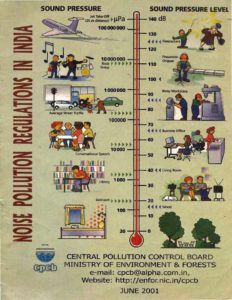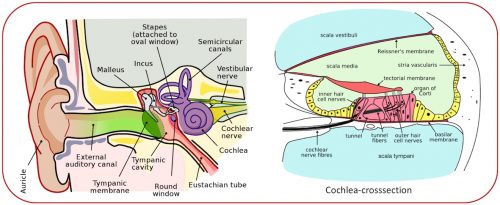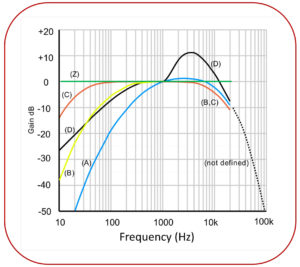Hearing Hazards and Noise Induced Hearing Loss
Noise Hazards and Hearing Loss
Everyday you communicate with other people, listen to music, and when you cross a street, you can avoid getting crushed by a car, because you hear it. Sound plays an important positive role in your life, but it can also have some very negative effects depending upon its intensity and for how long you are exposed to it. You might listen to music from your cell phone or in a concert and love it, but have you asked yourself at which level of intensity your ears will not be damaged?
Exposure to high noise levels can lead to permanent hearing loss. Short-term exposure to loud sounds can cause a temporary change in hearing (the ears may feel stuffed) or induce spurious sounds like ringing, in the ears (tinnitus). Sometimes these problems only persist for a short time after you leave the noisy environment. However, repeated exposure to loud sounds can lead to permanent loss of hearing or persistence of tinnitus. Recent research suggests, that even in cases when the loss of hearing seems to disappear, there may be residual long-term damage to your hearing.
Loud noise causes physical and psychological stress, reduces productivity, interferes with communication and concentration, and promotes accidents on the street or in the workplace. It renders difficult hearing surrounding sounds and warning alarms. A normal human being can hear sound frequencies between 20 Hz and 20,000 Hz. Noise-induced hearing loss limits the ability to hear high-frequency sounds, understand speech and severely impairs the ability to communicate.
Loss of hearing has very serious consequences as it affects your ability to communicate with other people, participate in social activities, listen to your favourite music, or watch movies. It contributes to psychological and social isolation.
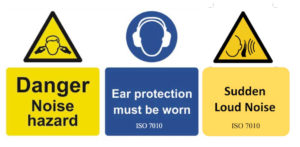
How does the ear work and what causes noise damage?
The structure of the ear is shown in the figure below. When sound waves enter the outer ear, the vibrations impact the ear drum and are transmitted to the middle and inner ear. In the middle ear three small bones called the malleus (or hammer), the incus (or anvil), and the stapes (or stirrup) amplify and transmit the vibrations generated by the sound to the inner ear. The inner ear contains a snail-like structure called the cochlea which is filled with fluid and lined with cells with very fine hairs. These tiny hairs move with the vibrations and convert the sound waves into nerve impulses–the result is the sound we hear.
Hair cells can be destroyed by loud noise exposure and lead to hearing loss. Extremely loud bursts of sound, such as gunshots or explosions, can rupture the eardrum or damage the bones in the middle ear.
Noise level measurements.
Sound levels are measured with instruments called sonometers (or sound level meter/decibelometer), but today you can also get a good idea of the sound levels around you using easily available smart phone apps. We invite you to do that to get an idea of sound levels around you and avoid excessively noisy environment. There are many apps available, here are some:
N.B.! To be sure that the app you use is accurate, you should really check it against the laboratory sonometer.
A few words about sound levels. Noise is measured in units of sound pressure levels called decibels, named after Alexander Graham Bell. Decibels are measured on a logarithmic scale which means that a small change in the number of decibels results in a huge change in the amount of noise and the potential damage to a person’s hearing. Examples of noise levels and what correspond to sound hazard, are given in the figure below. The human ear responds better to frequencies in the 500 Hz and 10 kHz range and is less sensitive to very low-pitch or high-pitch noises. In order to ensure that a meter is measuring what you actually hear the measurement is weighted to correct for the human ear response.There exist several types of weighting. A, C and Z weightings are commonly used today.
- A-weighting, cuts off the lower and higher frequencies that the average person cannot hear. A-weighted measurements are expressed as dBA or dB(A).
- C weighting. The response of the human ear varies with the sound level. At levels of 100 dB and above, the ear’s response is flatter and is approximated by a the C-Weighted response curve, which is flatter in the 50Hz to 5000Hz range. C weighting is usually used for Peak measurements and also in some entertainment noise measurement, where the transmission of bass noise can be a problem. C-weighted measurements are expressed as dBC or dB(C).
- Z-weighting is a flat frequency response of 10Hz to 20kHz. Z-weighted measurements are expressed as dBZ or dB(Z).
Sound level measurements should be made using the correct frequency weighting – usually A-weighting. For example, measuring a noise of around 50 Hz could result in about a 30 dB error if using C-weighting instead of A-weighting.
How loud is too loud?
Permanent noise-induced hearing loss is related to the sound pressure level and frequency distribution of the noise, the time pattern and duration of exposure, and individual susceptibility. Different countries set different levels of allowable noise exposure for 8h at workplace.
In 1997 the International Institute of Noise Control Engineering (I- INCE) published its report on “Technical Assessment of Upper Limits on Noise in the Workplace“. It recommended a limit of 85 dB(A) for 8 hour workshift and the maximum sound pressure level as limit of 140 dB for C-weighted peak. It recommended use of personal hearing protection when engineering noise control measures are insufficient to reduce daily exposure to 85 dB(A) and indicates that these should be mandatory when exposure level is over 90 dB(A). Typically the 85dbA level limit is used in many countries, but in some can be 90dBA as in India.
Examples of noise levels.
Examples of noise levels are given on the cover image of the Booklet on Noise hazards shown at the beginning of this page.
- The humming of a refrigerator- 45 decibel.
- Normal conversation- 60 decibels
- Noise from heavy city traffic- 85 decibels (hearing protection recommended at this level ; mandatory above 90 decibels)
- Motorcyles- 95 decibels.
- An MP3 player at high volume- 105 decibels (read EU report).
- Sirens – 120 decibels.
- Firecrackers and firearms- 150 decibels
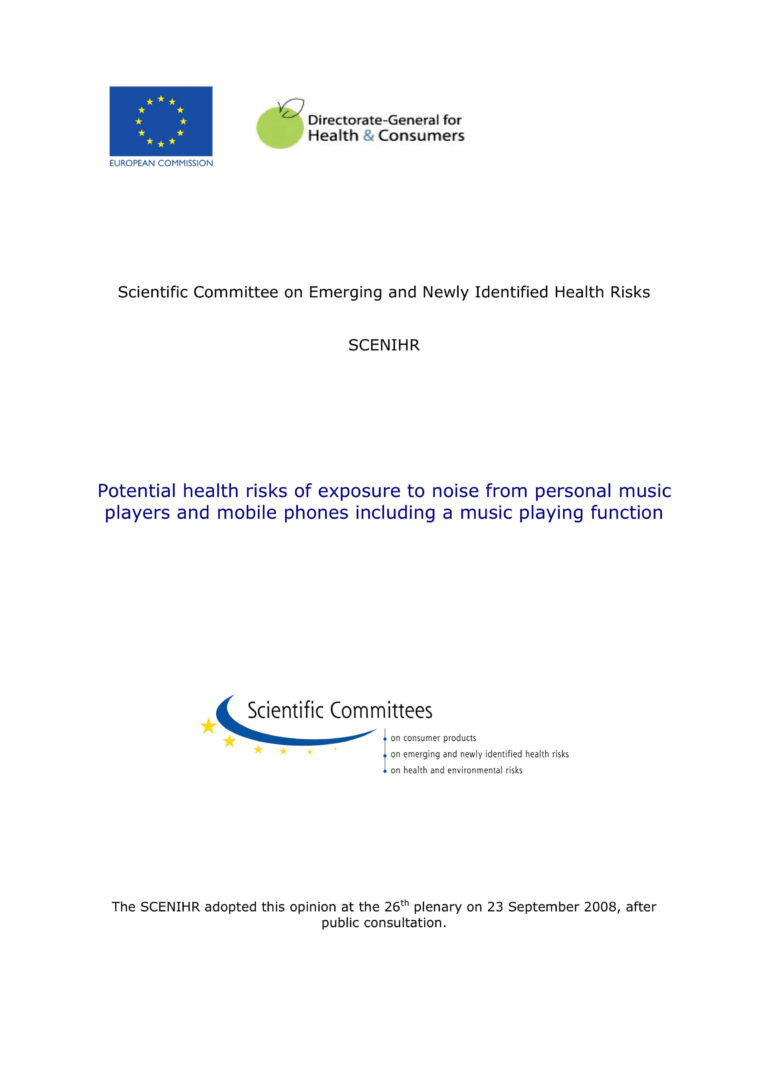
How to protect yourself from noise induced hearing loss.
What are the warning signs that your surrounding may be too noisy?
- You hear ringing or humming in your ears when you leave work.
- You have to shout to be heard by your companion at an arm’s length away.
- You experience temporary hearing loss when leaving work.
Noise hearing loss prevention?
If you understand the hazards of noise, you can protect your hearing for life. Follow these general guidelines:
- Know which noises can cause damage (those at or above 85 decibels).
- Wear earplugs or other protective devices when involved in a loud activity (activity-specific earplugs and earmuffs are available at hardware and sporting goods stores).
- If you can’t reduce the noise or protect yourself from it, move away from it.
- Be alert to hazardous noises in the environment.
- Reduce the sound level from a personal music player (cell phone etc).
- Protect the ears of children who are too young to protect their own.
- Make family, friends, and colleagues aware of the hazards of noise.
- Have your hearing tested if you think you might have hearing loss.
REFERENCES.
- US National Institute of Health
Exposure Criteria, Occupational Exposure Levels, Dr D.L. Johnson, Dr. P. Papadopoulos, Dr N. Watfa and Dr J. Takala
Potential health risks of exposure to noise from personal music players and mobile phones including a music playing function. Scientific Committee on Emerging and Newly Identified Health Risks SCENIHR
Noise Report 2016 (India).
A retrospective view of noise pollution control policy in India: status, proposed revisions and control measures. N.Garg and S.Maji.
Industrial Law, India

